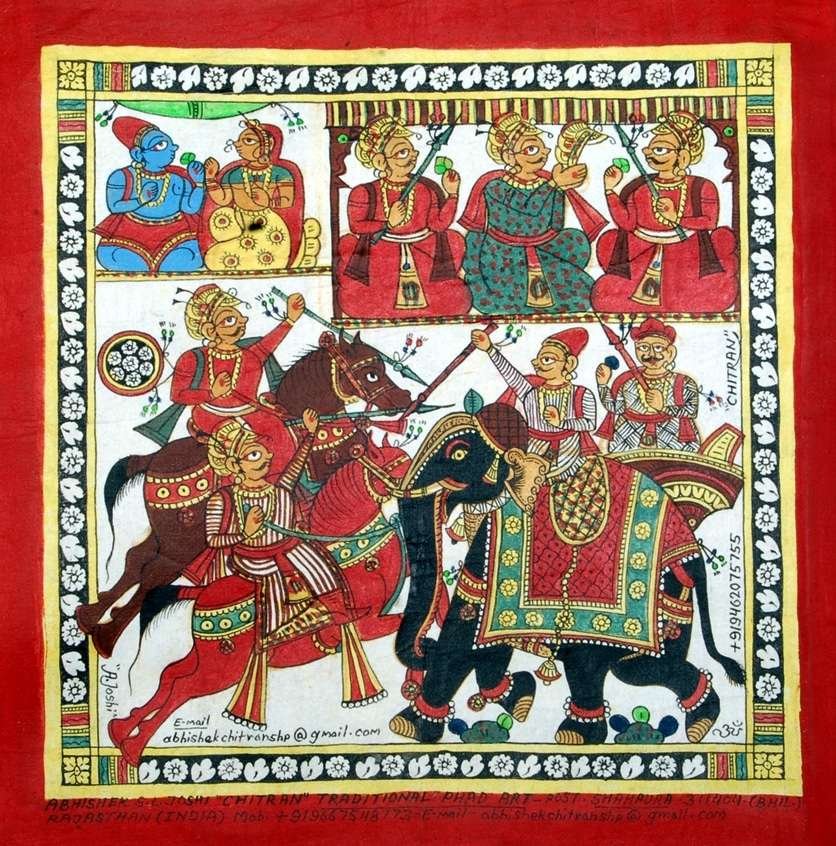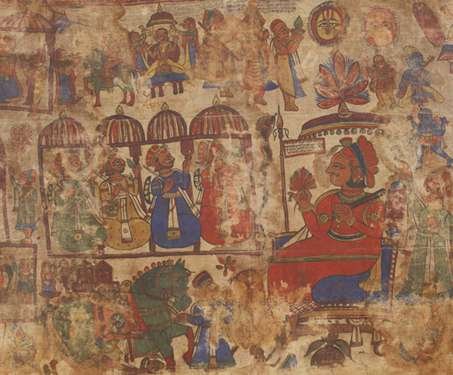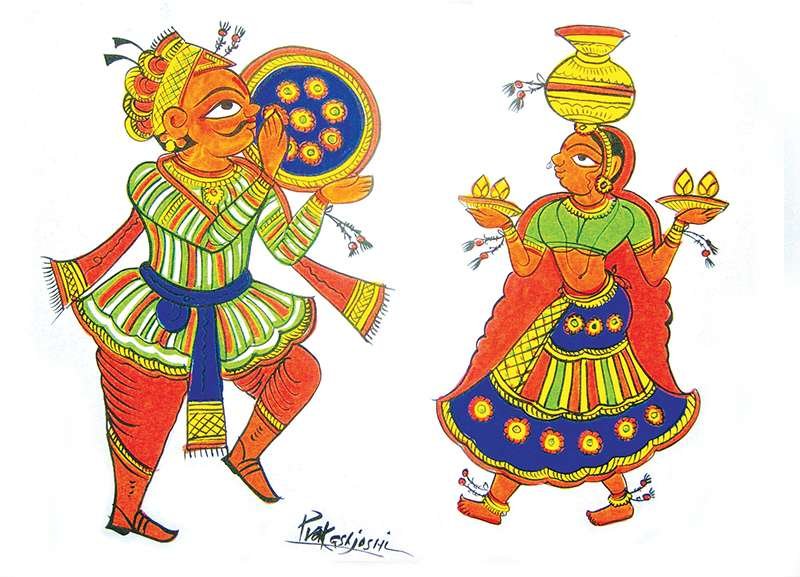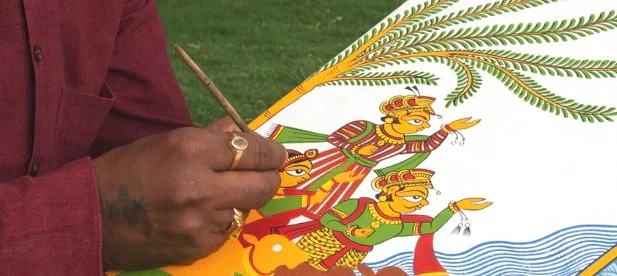Introduction to Phad Paintings
What Are Phad Paintings?
Rajasthani phad paintings are a stunning example of traditional Indian art. These paintings are renowned for using vivid colors and minute details to tell tales. Typically, they are enormous scrolls that illustrate legendary tales of gods, heroes, and regional folklore. Phad art is among the most well-known Indian paintings and is a part of Rajasthan’s rich cultural legacy.
The paintings in this type of traditional Indian art function as a stage for live performances. The story is told by the priest-singer Bhopa, who gestures to various parts of the Phad scroll. Because the most popular stories revolve around the Rajasthani folk heroes Pabuji and Devnarayan, Phad is a special kind of visual art combined with storytelling.
Phad artwork is a priceless piece of Indian art, and its renown only gets stronger. Handmade, each piece can take days or even weeks to complete. They are among the most recognizable examples of traditional Indian art because of their vivid colors and intricate figures.

The Significance of Storytelling in Rajasthan
Rajasthani culture has always placed an emphasis on storytelling. The Rajasthani people have been using stories for centuries to impart their culture, values, and beliefs. These tales are not only communicated verbally but also through conventional Indian artistic mediums. Long scrolls known as “phad art” tell epic tales of gods, heroes, and regional legends. Phad art is one of the most distinctive and well-known types of Indian art because it combines storytelling with painting.
These painted scrolls serve a purpose other than decoration in Rajasthan. Storytellers utilize them to present elaborate tales, frequently in front of large audiences. This custom helps individuals remember their history and keeps the stories alive. Phad and other Indian art paintings are vivid and detailed, capturing not just the story’s events but also the characters’ feelings. It’s a fantastic way to learn about Rajasthan’s rich past.
Overview of Epic Traditions in Indian Art
Indian art is renowned for carrying an emotionally compelling connection. Indian artists have been using their artistic talents to paint legendary tales to life for ages. Indian art is filled with vivid themes that pique the interest, from historical events to religious tales. Famous epics like the Ramayana and Mahabharata, two of the most significant tales in Indian culture, are frequently emphasized in traditional Indian art. Numerous Indian artworks that highlight the rich cultural legacy of the nation have been influenced by these stories.
Rajasthani Phad art stands out among the numerous other genres. The way that these enormous scroll paintings blend performance and art makes them special. Phad art tell the stories of local heroes and deities, making them a vital component of famous Indian art. Storytellers carrying these scrolls typically sing the stories portrayed in the paintings, providing a fully immersive visual and audio experience.
Historical Origins of Phad Painting
The Roots of Phad: Myth and History
The origins of Phad artwork are thought to date back more than 700 years, and they are closely associated with the legends of regional deities like Pabuji and Devnarayan. The cultural identity of Rajasthan is centered around these people, who are revered as folk heroes and protectors. Priests and storytellers, the Bhopa group, were instrumental in keeping this ancient Indian art form alive. They would transport the Phad scrolls and tell these heavenly stories, frequently for the villages’ religious and recreational purposes.
The Joshi family of Shahpura has historically served as the principal guardian of this well-known Indian artistic heritage. The skills and expertise needed to create Phad art have been passed down through the years, staying within their family and guaranteeing its continued existence. The artwork is a singular piece of Indian art history since it not only depicts the legendary tales but also offers an insight into the social and cultural life of ancient Rajasthan.
The Bhopa-Bhopi Tradition: Priests and Performers
The Bhopi is the husband of the Bhopa, a priest and storyteller who is typically a man, and she sings with him. They all perform together in front of a picture by Phad that acts as their background. These enormous scrolls are painted with scenes from well-known Rajasthani folktales, like the Tales of Devnarayan and Pabuji. In addition to providing entertainment, their job is to protect the rich history of Rajasthan’s well-known Indian art.

The Bhopa plays a string instrument known as a ravanhatta, which serves to build the mood for the story. The story is accompanied by singing and dancing by the Bhopi. The Phad painting behind them slowly unfolds while they perform, revealing each chapter of the narrative. Phad’s paintings and their topics can be strongly connected to by audiences through this tradition, which is both an emotional and visual trip. This custom contributes to the survival of traditional Indian art. The Phad painting would simply be another work of art on a wall without the Bhopa and Bhopi. These well-known tales come to life through their performances, elevating them above art.
Early Masters of the Phad Art Form
The Joshi family is among the most well-known for having contributed to Phad art. This family has been crafting these intricate scrolls for many generations. Mr. Shree Lal Joshi, a Joshi family great artist. He is noted for modernizing Phad while maintaining faithful to its roots. His efforts made this artwork known to a larger audience and established it as a well-known form of Indian art. The Phad art form legacy has survived because of artists such as Shree Lal Joshi.
Phad artists were formerly supported by the royal family. They painted for wealthy families and kings who admired traditional Indian art. The early masters of Phad art were instrumental in bringing their works to the attention of people all over the world today.
Themes and Epics Depicted
Who is Pabuji and why is he called Protector of Cattle?
Rajput warrior Pabuji was. He was a 14th-century nobleman. For his bravery and kindness, he gets honored. His tale demonstrates the great devotion Rajasthanis have for their animals, especially their cattle. In Rajasthan, cattle are essential to agricultural and day-to-day living. The tradition states that Pabuji engaged in numerous combats to defend his town and its farm animals. He was particularly close to the animals.

He supposedly had knack for interacting with them. Because of this relationship, he was very well-liked by the villagers. A well-known tale describes how Pabuji rescued his town from a lion. The animals were under attack by the lion. Pabuji courageously faced and subdued the lion. He became a hero as a result of this deed, and people started to revere him as a guardian.
Numerous artworks depict Pabuji riding his horse. He is usually surrounded by farm animals and has a sword in one hand. These artworks honor his bravery and his passion. They also showcase Rajasthan’s vibrant culture. Camel and cows are vital in Rajasthan. They assist with farms, deliver milk, and facilitate travel. For the people, Pabuji represents their moral principles. He is a symbol of fortitude, defense, and animal kindness.
Devnarayan: A Folk Deity

In the legends, Devnarayan is descended from a royal line. From a young age, he demonstrates amazing courage. He keeps the wicked guys out of his community and keeps its citizens safe. Several traditional Indian art forms praise his persona. Different scenes from his life are depicted in each picture. Some tell the story of his birth, while others focus on his conflicts with evil forces. These paintings make use of vivid, bright colors. He is prayed to for protection and wealth.
Other Lesser-Known Phads: Stories of Valor and Faith
There is a lesser-known Phad regarding Tejaji. Tejaji is a Rajasthani folk hero. His is a brave and selfless narrative. He supposedly rescued numerous cattle from a vicious serpent. Tejaji defended the villagers and battled valiantly. He faces the snake while mounted on a horse and brandishing a sword in his Phad artwork. We are reminded of the value of bravery and defense by this painting.
Another captivating tale is that of Goga Ji. Many people consider Goga Ji to be a divinity. His life and miracles are shown in his Phad artwork. It is well known that he aids those in need. He is credited for saving a young person from danger in a well-known tale. In most images, Goga Ji is seen holding a flag while riding a horse. For his devotees, this represents safety and hope.
The Making of a Phad Painting
Tools and Materials Used in Phad Art
- Canvas: Typically, fabric made of cotton is used for the canvas in Phad art. This cloth is great for painting considering it is strong and thick. To attain a smooth surface, artists tightly stretch the fabric. For smaller pieces, some people might even use handmade paper. The colourful intricate forms found in traditional Indian art have to be portrayed on this canvas.
- Natural Colors: These paintings’ use of natural colors is among its most significant features. On occasion, plants, minerals, and florals are utilized by artists to produce such colors. Red can be produced from clay, and yellow from turmeric, for example. Safe and unique, these colors help the paintings shine. A key element of traditional Indian painting is the incorporation of natural colors.
- Brushes: For more minute details, artists use brushes created from the hair of goats or squirrels. The bristles enable the development of sophisticated designs through the use of precise strokes. Certain artists also apply unique effects using their fingers. All which characterizes each painting is its unique touch.
- Tools for Detailing: In addition to brushes, artists use other tools for detailing their work. Small sticks or bamboo sticks help create fine lines and patterns. These tools allow artists to add texture and depth to their paintings. The combination of these tools helps bring out the stories depicted in paintings.
- Adhesives and Varnishes: Artists utilize natural materials to finish their paintings. Adhesive substances assist in preserving the vibrant shades and attaching the canvas. A glossy coat could be introduced once the painting is finished. This shields the painting from damage and dust while giving it a glossy finish. The fact that these components are used ensures an extended lifespan of renowned Indian art.
The Process: From Blank Canvas to Epic Scene
- Preparing the Canvas: Artists use cloth made from cotton or silk or generally “Khadi”. They stretch the cloth tightly on a wooden frame. This gives the canvas a smooth surface. After stretching, the artist applies a layer of mud and chalk. This layer makes the canvas ready for painting.
- Sketching the Design: Once the canvas is ready, the artist starts sketching the design. They use a light pencil to outline the main elements. This includes figures, animals, and scenes from epic stories. The paintings often tell tales from Indian epics. The artist pays close attention to details. Each figure has to look vibrant and expressive.
- Painting with Natural Colors: Phad artists use natural pigments for coloring their paintings. These pigments are made from minerals, plants, and other organic materials. For instance, they might use turmeric for yellow, indigo for blue, and charcoal for black. The colors are mixed with a binding agent, often made from gum, to ensure they adhere well to the canvas.
- Adding Fine Details: With the colors ready, the artist begins filling in the outlines. They usually start with the larger areas, like the background and main figures. For example, if the scene features a village, the artist paints the houses and fields first. They apply the colors using fine brushes made from animal hair, ensuring that the application is precise and smooth. This step is essential as it lays down the primary visual elements of the painting. After the base colors are applied, the artist focuses on adding fine details. This includes intricate patterns on clothing, facial expressions, and ornamental designs. The clothing of characters is often filled with complex motifs, reflecting Rajasthani culture. For instance, the artist may use gold leaf or metallic paint to highlight jewelry or weapons, making the artwork even more captivating.
- Highlighting and Shading: Once the details are in place, the artist begins the highlighting and shading process. This step adds depth and dimension to the painting. For instance, they might use a lighter shade of a color to highlight areas that catch the light, such as the tips of a horse’s mane. Conversely, they apply darker shades in the crevices to create shadows. This technique enhances the three-dimensional look of the characters and the overall scene.
Decoding the Iconography of Phad
- The Central Figure: In most of these paintings, you will find a central figure. This figure is often a god or a hero from Indian epics. For example, in the story of Pabuji, he is depicted as a brave warrior. His image usually captures his strength and valor. This central figure draws the viewer’s eye and sets the stage for the story being told.
- Color Choices: Red often represents power and passion. Green symbolizes nature and life. Yellow is linked to joy and celebration. Artists carefully choose colors to express emotions and themes in their work.
- Decorative Borders: These borders often contain intricate patterns and smaller figures. They serve two purposes: they frame the main story and add visual interest. The designs in the borders can also include motifs like flowers or animals, which represent different meanings. For instance, a peacock might symbolize grace and beauty.
- The Use of Symbols: Artists use them to convey deeper meanings. A snake might represent protection, while a lotus can symbolize purity. Understanding these symbols can help viewers connect with the stories on a personal level.
- The Narrative Flow: The paintings often tell a story that unfolds across the canvas. Viewers can follow the action by looking from left to right. The arrangement of characters and scenes guides the viewer through the tale.
Threats to Traditional Phad Art
The lack of talented artists poses a serious threat to Phad’s works. A large number of youths are unwilling to study this skill. They favor more financially rewarding modern employment. Additionally, Phad and other traditional Indian art forms face challenges from modern living. Many people in Rajasthan are moving to cities for work. People frequently forget their culture and customs when living in cities. For young artists, this transition makes it difficult to stay connected to their beginnings. Their curiosity in studying well-known Indian arts, such as the Phad artform, may wane.
Finding the supplies needed to create is getting harder. Traditional materials, such certain kinds of fabric and natural hues, are frequently swapped out for less expensive substitutes. The artwork’ quality is impacted by this modification. Artists are unable to create the same exquisite work as before in the absence of appropriate supplies.
Even in India, there are many folks who are unaware about this type of art. Relative to other well-known Indian art forms like Warli or Madhubani art, they are not as well-known. People who are unfamiliar of Phad’s work are less likely to support or consume it. This indifference may be a threat to this lovely art form’s survival. Traditional Indian art is also impacted by India’s economic circumstances. Getting a fair compensation for their work is a challenge for many artists.
The Enduring Legacy
Phad paintings are more than just beautiful art pieces; they are a window into Rajasthan’s rich culture and history. This traditional Indian art form tells stories of heroes and gods, connecting people to their past. The vibrant colors and intricate details make Phad paintings famous Indian art. They are not just decorations; they carry the essence of storytelling and spirituality.
Phad paintings are more than just amazing pieces of art; they serve as a window into the rich past and culture of Rajasthan. This centuries-old Indian art form connects humans to their past by narrating legends of gods and heroes. Phad’s paintings are renowned Indian paintings due to the bright colors and tiny details. They reflect the spirit of spirituality and storytelling, which makes them far more than simply decorations.
In order to sum up, this is an important aspect of Rajasthani heritage and culture. Their bright colors, fascinating tales, and strong connections to the community provide an enduring legacy. We remember the centuries of tradition and artistry that make these paintings exceptionally outstanding.
For further reading on Phad Paintings and its significance, you can visit these useful resources:
These references will help you dive deeper into the fascinating history and artistry of Phad Paintings.
Checkout our Blog Page on the Traditional Indian art.









Leave a Reply